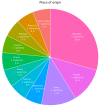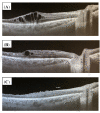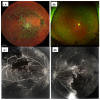Treatment in Latent Tuberculosis Uveitis-Is Immunosuppression Effective or Is Conventional 3- or 4-Drug Antituberculosis Therapy Mandatory?
- PMID: 35566544
- PMCID: PMC9105017
- DOI: 10.3390/jcm11092419
Treatment in Latent Tuberculosis Uveitis-Is Immunosuppression Effective or Is Conventional 3- or 4-Drug Antituberculosis Therapy Mandatory?
Abstract
Background/Aims: Controversy exists regarding 3- or 4 drug antituberculosis therapy (conventional ATT) in uveitis patients having latent tuberculosis (LTB), especially while initiating therapy with corticosteroids and/or other immunosuppressants. Methods: We performed a monocentral retrospective analysis of posterior uveitis patients with latent TB. Latent TB was diagnosed, in case of a positive QuantiFERON®-TB-Gold test and normal chest imaging, after ruling out other causes of infectious and noninfectious uveitis. Patients with active TB were excluded. From 2016 to 2020 we included 17 patients. Ophthalmological evaluation consisted of Best corrected visual acuity (BCVA), slit lamp examination, fundoscopy, OCT, and fluorescein- and indocyaningreen- angiography before and at months 3, 6, 12, 24, and the last follow-up after treatment. Results: Initially, all patients had active posterior uveitis with occlusive (n = 5 patients) and nonocclusive retinal vasculitis (n = 12 patients). Mean follow up was 28 ± 15 months. Therapy was started with systemic corticosteroids (mean prednisolone equivalent 71.3 mg/d) and already after 3 months it could be tapered to a mean maintenance dosage of 8.63 mg/d. Additional immunosuppressive treatment with cs- or bDMARDs was initiated in 14 patients (82%) due to recurrences of uveitis while tapering the corticosteroids <10 mg per/day or because of severe inflammation at the initial visit. While being on immunosuppression, best corrected visual acuity increased from 0.56 logMAR to 0.32 logMAR during follow-up and only three patients had one uveitis relapse, which was followed by switch of immunosuppressive treatment. As recommended, TB prophylaxis with 300 mg/d isoniazid was administered in 11 patients for at least 9 months while being on TNF-alpha-blocking agents. No patient developed active tuberculosis during immunosuppressive therapy. Conclusion: Mainly conventional ATT is strongly recommended—as monotherapy or in combination with immunosuppressives—for effective treatment in patients with uveitis due to latent TB. Although in our patient group no conventional ATT was initiated, immunosuppression alone occurred as an efficient treatment. Nevertheless, due to possible activation of TB, isoniazid prophylaxis is mandatory in latent TB patients while being on TNF-alpha blocking agents.
Keywords: antituberculosis therapy; immunosuppression; latent tuberculosis; posterior uveitis; retinal vasculitis; uveitis.
Conflict of interest statement
The authors declare no conflict of interest.
Figures









Similar articles
-
Review of people with retinal vasculitis and positive QuantiFERON®-TB Gold test in an area nonendemic for tuberculosis.Int Ophthalmol. 2018 Dec;38(6):2389-2395. doi: 10.1007/s10792-017-0739-4. Epub 2017 Oct 13. Int Ophthalmol. 2018. PMID: 29027603
-
The efficacy of latent tuberculosis treatment for immunocompetent uveitis patients with a positive T-SPOT.TB test: 6-year experience in a tuberculosis endemic region.Int Ophthalmol. 2018 Dec;38(6):2273-2282. doi: 10.1007/s10792-017-0716-y. Epub 2017 Sep 25. Int Ophthalmol. 2018. PMID: 28948453
-
Effect of Antituberculous Therapy on Uveitis Associated With Latent Tuberculosis.Am J Ophthalmol. 2018 Jun;190:164-170. doi: 10.1016/j.ajo.2018.03.032. Epub 2018 Mar 29. Am J Ophthalmol. 2018. PMID: 29604284
-
National Psoriasis Foundation consensus statement on screening for latent tuberculosis infection in patients with psoriasis treated with systemic and biologic agents.J Am Acad Dermatol. 2008 Aug;59(2):209-17. doi: 10.1016/j.jaad.2008.03.023. Epub 2008 May 15. J Am Acad Dermatol. 2008. PMID: 18485527
-
Recurrent Episodes with Serous Retinal Detachment and Anterior Uveitis in a Patient Using Nivolumab (Anti -PD-1 Antibody) Therapy: A case report and literature review.Semin Ophthalmol. 2021 Nov 17;36(8):794-799. doi: 10.1080/08820538.2021.1906916. Epub 2021 Mar 29. Semin Ophthalmol. 2021. PMID: 33780309 Review.
Cited by
-
Artificial Intelligence-Based Uveitis Diagnosis Through Retinal Vasculature Analysis: A Paradigm Shift in Ocular Tuberculosis.Ophthalmol Ther. 2025 Apr;14(4):717-732. doi: 10.1007/s40123-025-01103-4. Epub 2025 Feb 24. Ophthalmol Ther. 2025. PMID: 39992617 Free PMC article.
-
Relapse in ocular tuberculosis: relapse rate, risk factors and clinical management in a non-endemic country.Br J Ophthalmol. 2024 Nov 22;108(12):1642-1651. doi: 10.1136/bjo-2024-325207. Br J Ophthalmol. 2024. PMID: 38609164 Free PMC article.
-
Mycobacterium tuberculosis Infection of Retinal Endothelial Cells Induces Interferon Signaling Activation: Insights Into Tubercular Retinal Vasculitis.Invest Ophthalmol Vis Sci. 2025 Jul 1;66(9):48. doi: 10.1167/iovs.66.9.48. Invest Ophthalmol Vis Sci. 2025. PMID: 40668059 Free PMC article.
-
A systemic review of the utility of antituberculosis therapy for presumed tuberculous uveitis.BMC Infect Dis. 2025 Jan 24;25(1):112. doi: 10.1186/s12879-024-10288-1. BMC Infect Dis. 2025. PMID: 39856576 Free PMC article.
-
Uveitis in the Pediatric Population and Therapeutic Management: A Current Literature Review.Children (Basel). 2024 Jun 25;11(7):769. doi: 10.3390/children11070769. Children (Basel). 2024. PMID: 39062219 Free PMC article. Review.
References
-
- WHO . Global Tuberculosis Report 2020. WHO; Geneva, Switzerland: 2020.
-
- Nora R.L.D., van Velthoven M.E., dam-van Loon N.H.T., Misotten T., Bakker M., van Hagen M.P., Rothova A. Clinical Manifestations of Patients With Intraocular Inflammation and Positive QuantiFERON–TB Gold In-Tube Test in a Country Nonendemic for Tuberculosis. Am. J. Ophthalmol. 2014;157:754–761. doi: 10.1016/j.ajo.2013.11.013. - DOI - PubMed
-
- Nora R.L.D., Walburg K.V., Van Hagen P.M., Swagemakers S.M.A., Van Der Spek P.J., Quinten E., Van Velthoven M., Ottenhoff T.H.M., Dik W.A., Haks M.C. Retinal Pigment Epithelial Cells Control Early Mycobacterium tuberculosis Infection via Interferon Signaling. Investig. Opthalmol. Vis. Sci. 2018;59:1384–1395. doi: 10.1167/iovs.17-23246. - DOI - PubMed
LinkOut - more resources
Full Text Sources
Research Materials

